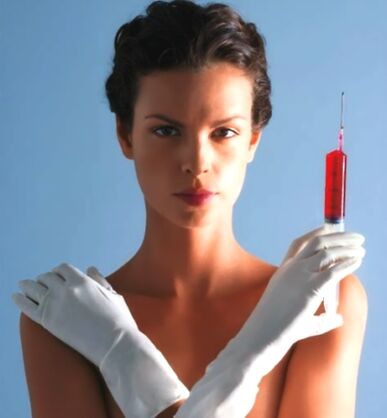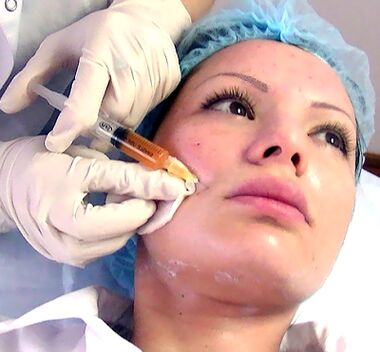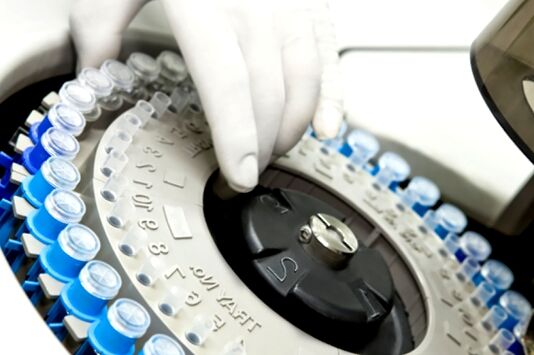It is now fashionable to be well-groomed, young, beautiful. But youth is a gradual phenomenon, and because we want to preserve it for as long as possible, beauticians provide this opportunity by developing, demonstrating, and applying the latest, most effective techniques, rejuvenation procedures. But what should you choose from the wide range of modern cosmetic procedures if you want to prolong your youth and beauty, rejuvenate your skin and put your body in order? This article explores in detail the essence of one of the latest techniques - plasmolifting - and talks about the safety and high efficiency of this technique.
What is plasmolifting

Human blood has a huge potential that can stimulate all the resources of the body that are so necessary to fight the aging process and age-related changes, rejuvenate the skin and restore general tissues. And the plasmolifting process contributes to the highly efficient exploration of all these possibilities. What is plasmolifting, based on how this cosmetology procedure works, effectively rejuvenates the skin and subcutaneous tissues?
Plasmolifting is a cosmetological procedure, a non-surgical technique that performs skin rejuvenation, activating the tissue regeneration processes in the human body. This is the latest method that has revolutionized cosmetology. The principles and ideas of the technique, like all geniuses, are very simple. This cosmetology procedure, its main concepts are based on the ability of a human patient to restore platelet-rich blood plasma. The resulting plasma is injected into problem areas of the skin. Thanks to such injections, the human body receives a strong stimulus to activate the natural rejuvenating and regenerative processes.
Such stimulatory properties of platelet-rich plasma ensure the formation of skin cells from stem cells, the normalization of metabolic processes, the formation of hyaluronic acid molecules, the stimulation of blood circulation, and the increase of elastin and collagen production. Rejuvenation of the skin and deeper subcutaneous tissues begins.
There are many other synonyms for this cosmetology procedure, such as ACR - autologous cell rejuvenation, skin autojuvenation, autoplasmic skin therapy, skin plasma revitalization, plasma biorevitalization, hemorejuvenation, plasma biorevitalization, "draculotherapy".
The plasmolifting procedure is in part similar to biomesotherapy in that it uses the patient's biomaterials for injection, thus ensuring the fullest compatibility of the biological components and eliminating the possibility of complications in the form of allergic reactions.
Plasmolifting is similar to a cosmetology procedure called ReGen Lab developed by Swiss experts, which rejuvenates both the skin and the tissues under the skin. But this is a more expensive procedure and requires expensive hardware.
History of the appearance of plasmolifting
Early precursors to this method include autohemotherapy (the transfusion of a patient's blood from a vein into the muscles of the buttocks to stimulate the body's defense function), which has been used in medicine for more than a hundred years, and plasma. therapy, a method of treating certain diseases by administering intravenous plasma.
The first experiments to rejuvenate human skin immediately before the advent of the plasmolifting method were conducted decades ago in the United States. As a result of these studies, a cosmetology procedure called PRP therapy (PRP-Plateled Rich Plasma) has emerged. The plasmolifting procedure is a modification of PRP therapy and was patented in 2004 by professionals.
Mechanism of action
In addition to accelerating blood clotting, platelets are able to secrete growth factor proteins that stimulate the process of cell division and growth. After injury, platelets usually accumulate near the wound, initiating the process of stopping the blood as well as repairing the damaged area.
In order for the cells to be artificially renewed, thereby causing skin rejuvenation, a minor injury must be caused, such as in a chemical peel, or the patient's body must be deceived by delivering platelets to the desired area. This operation serves as a signal to start the regeneration process.
Thus, platelet-rich plasma is injected into the right areas to help regenerate skin cells. Fibroblasts (connective tissue cells) begin to produce elastin, collagen, and hyaluronic acid efficiently, and the formation of new skin cells is accelerated and skin rejuvenation occurs.
Extent of plasmolifting
The plasmolifting procedure is widespread mainly in the field of cosmetology. Extremely effective and fast, painless skin rejuvenation is his merit. But this cosmetology procedure is also successfully used in trichology as an effective way to combat baldness and hair loss. After multiple plasmolifting, the structure of the hair is restored, hair loss is stopped and the process of healthy hair growth begins. Treatment of hair loss and baldness may require 2-10 plasmolifting procedures, depending on the general condition of the hair.
Plasmolifting has been used successfully in dentistry to speed up the process of implant placement and to treat periodontitis.
Indications for plasmolifting

The following indications are used to perform the plasma charging procedure:
- exfoliating and dry skin;
- prevention of stretch marks with sharp weight loss;
- Over 25 years of age. Mimicry and small wrinkles - over 35 years of age;
- violation of the essential properties of the skin due to weight loss;
- primary signs of skin prolapse, decreased firmness and elasticity;
- acceleration of skin tissue regeneration processes after laser and chemical peeling;
- acne and other dermatological diseases;
- age-related elastosis, "gray" skin;
- skin recovery after strong UV radiation (sunbathing, solarium);
- rare dull hair;
- baldness and dandruff;
- correction of the ill effects of Botox injections.
Contraindications to plasmolifting
The plasmolifting procedure has the following contraindications:
- mental disorders;
- severe sagging of the skin;
- blood diseases;
- immune disorders;
- chronic diseases;
- exacerbation of various chronic diseases;
- diabetes in severe form;
- diseases of various internal organs of the patient;
- allergy to anticoagulants used to make injections;
- menstruation;
- oncological diseases;
- hypofibrinogenemia;
- platelet abnormalities and dysfunctions, low platelet count (less than 100, 000 per 1 µl);
- low hemoglobin (less than 100 g / l);
- fever, high temperature;
- pregnancy;
- use of antibiotics;
- lactation;
- antiplatelet therapy;
- use NSAIDs (non-steroidal anti-inflammatory drugs) such as aspirin, analgesic less than two days before the procedure;
- inflammation of the skin at the injection site.
This cosmetology procedure is subject to the following main restrictions on the patient before it is performed:
- ban on going to the solarium;
- prohibition of natural tanning;
- a ban on access to pools and saunas.
Plasmolifting procedure: implementation

Before starting the procedure, it is recommended to perform some tests: biochemical and clinical blood test, blood test for the presence of infectious diseases. Blood is then taken from the patient's vein into a test tube containing a separating gel and anticoagulant. The amount of blood drawn depends primarily on the individual and biological characteristics of the patient. Usually about 10-20 ml. The blood is then divided into three fractions using a special centrifuge:
- cellular component (leukocytes and erythrocytes);
- platelet-rich plasma (approximately 1 million / l µl);
- platelet-poor plasma (less than 150, 000/1 µl).
Platelet-enriched blood plasma is injected with microinjections into problem areas previously treated with an antiseptic solution. Once introduced, fibroblasts are placed along the Langer line (an age-related natural stretching line). By stimulating the production of elastin and collagen, the skin becomes firmer. The microinjection technique is generally similar to mesotherapy.
If necessary, anesthesia with a special cream can be used. At the end of the procedure, the areas where the plasmolifting procedure was performed are again treated with disinfectant. In the first 3 days after plasmolift, patients usually experience redness and peeling, as well as a slight darkening. Small wrinkles may appear on the surface of the skin. It usually goes away after three days.
The duration of the procedure is usually 40-50 minutes. The basic course of plasmolifting consists of 4 sessions with a frequency of 1-2 weeks. And in order to maintain and consolidate the achieved effect, about 2 courses of plasmolifting must be repeated every year.
To prevent unpleasant side effects, the authors of plasmolifting are prohibited from further modifying the method, for example by adding other components, vitamins to the platelet-rich plasma.
The main advantage of the plasma skin rejuvenation process compared to other cosmetic procedures - over time, the stimulating process of collagen production, ie the improvement of the general condition of the skin, skin rejuvenation will continue in the coming months, up to a year. inclusive.
Plasmolifting procedure: efficiency
In 40 percent of cases, the effect is noticeable almost immediately after plasmolifting. In all other cases, this performed cosmetic procedure does not appear immediately, the results appear after about 2 weeks. In order to achieve a more pronounced, better effect, experts suggest several procedures. This will make the skin rejuvenated in the treated area very noticeable. The result of the procedure can take up to two years.
The effect thus obtained is comparable to the chemical exfoliation of the skin of the neck and face: it becomes younger, more elastic, its color improves, and fine wrinkles are smoothed out. After the procedure, the most obvious result is the effect of "porcelain skin" - the skin becomes very velvety, soft and smooth, as if it shines from the inside. rejuvenate the skin. If there are deeper wrinkles or a blurred oval on the face, then this cosmetological procedure will not give good results.
The following is the average recommended duration of a plasma lifting regimen and the results obtained for the following most common skin problems:
- skin ptosis. Result: increased turgor and skin tone. 4-6 procedures 1 time in 7 days.
- Wrinkles. Result: decrease in the depth and number of wrinkles, slowing of age-related changes. 4-6 procedures for 1 time every 7 days.
- Photo aging. Result: Elimination or reduction of hyperpigmentation, photoaging. 4-6 procedures for 1 time every 7 days.
- Tired skin. Result: circles under the eyes, reduction of swelling and improvement of complexion, local increase in skin immunity. 2-4 treatments, 1 time every 7 days.
- Problematic skin. Result: the appearance of acne is reduced, the condition of the skin is improved, it is relieved. 4-6 procedures for 1 time every 7 days.
- Dry wine. Nutrition and hydration, activation of metabolic processes. 2-4 treatments, 1 time every 7 days.
- Hair loss, baldness. Result: inhibition of hair follicle extinction processes, activation of hair growth. 4-6 procedures for 1 time every 7 days.
- Dry, thin hair. Result: increased blood supply and nourishment of hair follicles, restoration of hair structure. 2-4 treatments 1 time every 7 days.
- Dandruff, oily scalp problem. Normalization of sebaceous glands, elimination of dandruff. 4-6 procedures 1 time every 7 days.
Plasmolifting procedure: safety
Plasmolifting is an absolutely safe cosmetology procedure that provides almost painless skin rejuvenation without serious subsequent complications. Injections of platelet-rich plasma are non-immunoreactive and non-toxic because, as mentioned above, such plasma is obtained from the patient's blood without the addition of additional substances and drugs. Because the plasma rejuvenation procedure helps to activate the body’s hidden resources, such skin rejuvenation does not cause any rejection reaction. Minor complications are possible, such as patches on the skin, redness, necrosis, hypopigmentation. In addition, this cosmetic procedure has no recovery period. It should be noted that such complications are theoretically possible, but the chances of their occurrence are extremely low.
Combination with other procedures
The plasmolifting process can be perfectly combined with other cosmetic anti-aging methods, such as all types of peeling and laser surface treatment. This is when skin rejuvenation appears most effectively. In addition, this cosmetology procedure is perfect for the preparation of the skin before plastic surgery, to improve its condition and appearance in the post-surgery healing period. The plasmolifting method can be combined with other laser methods to achieve maximum efficiency:
- laser hyaluronoplasty prepares the skin for an increase in hyaluronic acid content;
- laser photothermolysis makes it possible to consolidate the results obtained during plasmolifting;
- the combined laser enhances the resulting rejuvenating effect.
Plasmolifting procedure: cost
The plasmolifting procedure itself is inexpensive, as the patient himself is the carrier of the platelet-rich plasma, the centrifuge divides the blood into fractions, and the injection of the resulting drug can be performed by a qualified mesotherapy beautician. injections. The main component of the price of the plasmolifting process is intellectual property. But this cosmetic procedure is not that expensive.
The total cost is based on the number and area of areas treated.






































































